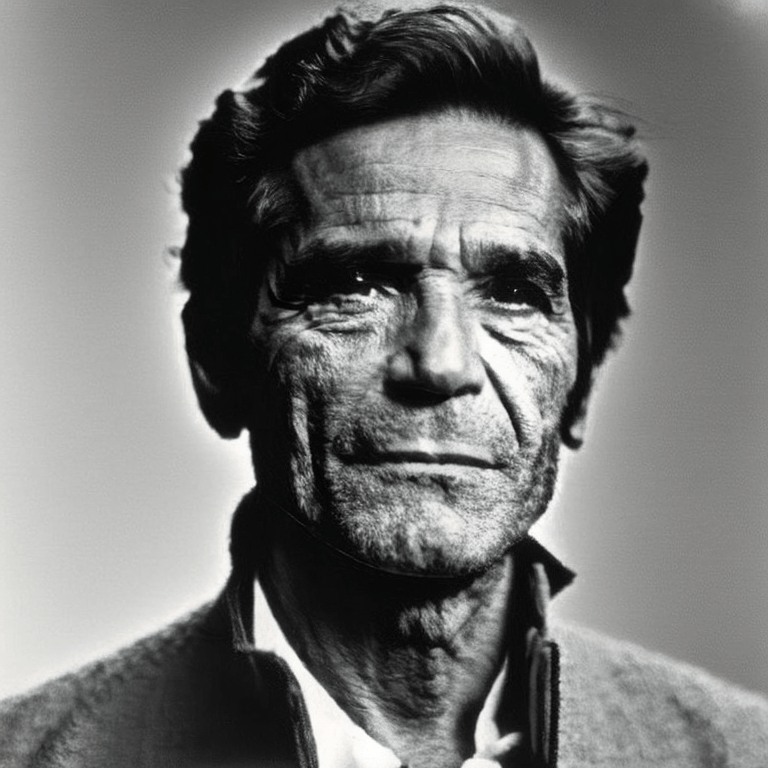
Introduction
Italian cinema boasts a rich history of influential filmmakers who have left an indelible mark on the world of cinema. Among these luminaries stands Pier Paolo Pasolini, a legendary figure revered for his thought-provoking films and unique directorial style. In this article, we will delve into the life and works of Pasolini, exploring his profound contributions to the world of cinema. Additionally, we will draw a comprehensive comparison between Pasolini's distinctive style and that of another prominent Italian filmmaker, Tinto Brass. So, let's embark on this captivating cinematic journey and uncover the brilliance of Pasolini's artistry.
Pasolini was not only a filmmaker, but also a poet, writer, intellectual, journalist, translator, playwright, visual artist and actor. He is considered one of the defining public intellectuals in 20th-century Italy, influential both as an artist and a political figure. A controversial personality due to his straightforward style, Pasolini's legacy remains contentious. Openly gay and a strong advocate for Christian values in his youth, he also became an avowed Marxist shortly after the end of World War II, while voicing strong criticism of petty bourgeoisie values and the emerging consumerism in Italy, juxtaposing socio-political polemics with a critical examination of taboo sexual matters. A prominent protagonist of the Roman cultural scene of the post-war period, he was an established major figure in European literature and cinema.
1. Early Life and Background
Pier Paolo Pasolini was born on March 5, 1922, in Bologna, Italy. Growing up in a modest background, Pasolini experienced the social and political turbulence of post-war Italy, shaping his perspective on society and influencing the themes portrayed in his films.
1.1 Childhood Influences
Pasolini's formative years were marked by a deep attachment to his rural roots and an early fascination with literature and the arts. These foundational influences laid the groundwork for his creative pursuits, providing him with a unique lens through which to observe and critique society.
Pasolini's family moved to different cities in northern Italy due to his father's military career. His father was also involved in identifying the would-be assassin of Benito Mussolini in 1926. Pasolini developed a close bond with his mother, who supported his artistic aspirations. He also had a younger brother, Guidalberto, who later became a journalist.
1.2 Academic Pursuits
Pasolini's academic journey led him to the study of literature and philosophy at the University of Bologna. This intellectual exploration further fueled his passion for storytelling and ignited his desire to convey powerful narratives through the medium of film.
Pasolini excelled in his studies and showed a remarkable talent for writing poetry and essays. He also became involved in various cultural activities and political movements, expressing his views on fascism, communism, Catholicism, and homosexuality. He graduated with honors in 1943.
2. Filmmaking Career and Themes
Pasolini's films were a reflection of his profound observations on society, politics, and culture. Through his work, he fearlessly explored controversial and provocative subjects, often challenging societal norms and conventions. Let's delve into some of Pasolini's notable films and the profound themes they encompassed.
2.1 "Accattone" (1961)
"Accattone" marked Pasolini's directorial debut and set the tone for his future works. The film vividly depicted the lives of marginalized individuals living on the fringes of society, unearthing the themes of poverty, desperation, and the relentless struggle for survival.
The film followed the story of Accattone, a petty criminal and pimp who lives off the earnings of his prostitute girlfriend Maddalena. When she is arrested by the police, Accattone is left without a source of income and tries to find another woman to exploit. However, he falls in love with Stella, a naive young girl who changes his outlook on life.
The film was shot in a neorealist style that captured the harsh realities of Rome's slums. Pasolini used non-professional actors who spoke in authentic Roman dialects. The film also featured an unconventional soundtrack that contrasted classical music with popular songs.
2.2 "Mamma Roma" (1962)
In "Mamma Roma," Pasolini delved into the complexities of motherhood and the harsh realities faced by women in a patriarchal society. Through the character of Mamma Roma, played brilliantly by Anna Magnani, the film portrayed the sacrifices, hardships, and unwavering determination of a mother fighting to provide a better life for her son.
The film began with Mamma Roma celebrating her freedom from her abusive pimp and former lover Carmine, who had forced her into prostitution. She reunites with her teenage son Ettore, whom she had left in the care of relatives, and moves to a new apartment in a modern neighborhood. She hopes to start a new life as a respectable fruit vendor and give Ettore a chance to pursue his education and dreams.
However, her past soon catches up with her, as Carmine reappears and threatens to expose her secrets. Ettore also falls into bad company and becomes involved in petty crimes. Mamma Roma tries to save her son from his fate, but her efforts prove futile.
The film was a poignant critique of the social and economic changes that occurred in Italy during the 1950s and 1960s, which failed to improve the lives of the poor and the oppressed. Pasolini also explored the themes of alienation, identity, and morality in a changing world.
2.3 "The Gospel According to St. Matthew" (1964)
This biblical adaptation presented Pasolini's distinctive take on religion, showcasing his belief in the transformative power of faith and the inherent importance of social justice. The film, shot in a neorealist style, received critical acclaim for its authenticity and powerful performances, immersing audiences in the emotional and spiritual journey of the iconic biblical figure.
The film followed the life of Jesus Christ from his birth to his crucifixion and resurrection, based on the Gospel of Matthew. Pasolini used a minimalist approach that avoided any embellishments or interpretations of the biblical text. He also cast non-professional actors, many of whom were locals from southern Italy, to portray the characters.
The film was praised for its artistic vision and its humanistic portrayal of Jesus as a revolutionary leader who challenged the oppression and corruption of his time. Pasolini also incorporated elements from his own cultural background, such as folk music, poetry, and art, to create a unique cinematic expression of faith.
2.4 "Salo, or the 120 Days of Sodom" (1975)
Considered Pasolini's most controversial and audacious film, "Salo" pushed the boundaries of cinema with its explicit and disturbing content. Set during World War II, the movie explored the themes of power, fascism, and the ultimate degradation of humanity. Though challenging and unsettling, "Salo" stands as a testament to Pasolini's unflinching commitment to unearthing uncomfortable truths.
The film was loosely based on the novel "The 120 Days of Sodom" by Marquis de Sade, but transposed to the context of Mussolini's regime in northern Italy. The film depicted the atrocities committed by four wealthy and powerful men who kidnapped 18 young men and women and subjected them to various forms of torture and abuse in a secluded villa.
The film was divided into four segments: Anteinferno, Circle of Manias, Circle of Shit, and Circle of Blood. Each segment represented a different level of depravity and violence inflicted by the captors on their victims. The film also featured stories narrated by four elderly prostitutes who described their own perverse experiences.
The film was banned in many countries for its graphic depiction of sexual violence, mutilation, murder, and cannibalism. Pasolini intended the film to be a metaphor for the moral decay and brutality of fascism and capitalism. He also wanted to expose the hypocrisy and complicity of society in allowing such horrors to happen.
3. A Comparison with Tinto Brass
Tinto Brass, another prominent Italian filmmaker, emerged during the same era as Pasolini and left an indelible mark on Italian cinema. While their styles differed significantly, both directors made noteworthy contributions to the industry.
3.1 Pasolini's Socio-Political Commentary vs. Brass's Erotic Exploration
One of the main differences between Pasolini and Brass was their approach to sexuality in their films. Pasolini used sexuality as a tool to critique society and reveal its contradictions and injustices. He often depicted sexuality as a form of oppression or resistance, depending on the context and perspective. He also explored taboo subjects such as homosexuality, incest, pedophilia, rape, and necrophilia.
Brass, on the other hand, used sexuality as a means to celebrate life and pleasure. He often depicted sexuality as a form of liberation or expression, regardless of the moral or social implications. He also explored erotic subjects such as voyeurism, exhibitionism, fetishism, orgies, and cuckoldry.
Both directors faced censorship and controversy for their explicit portrayal of sexuality in their films. However, while Pasolini aimed to provoke thought and debate with his films, Brass aimed to entertain and titillate with his films.
3.2 Pasolini's Neorealist Aesthetics vs. Brass's Pop Art Style
Another difference between Pasolini and Brass was their visual style and aesthetics in their films. Pasolini adopted a neorealist style that emphasized realism and authenticity in his films. He used natural locations, non-professional actors, minimal lighting, and long takes to create a documentary-like effect. He also used classical music and folk songs to create a contrast between the high and low culture.
Brass adopted a pop art style that emphasized stylization and experimentation in his films. He used artificial sets, professional actors, bright colors, and rapid editing to create a comic-like effect. He also used contemporary music and sound effects to create a playful and ironic tone.
Both directors used their visual style and aesthetics to convey their vision and message in their films. However, while Pasolini aimed to capture the harsh realities and complexities of society with his films, Brass aimed to capture the fun and frivolity of life with his films.
3.3 Pasolini's Intellectual Influence vs. Brass's Commercial Appeal
A final difference between Pasolini and Brass was their impact and influence on the film industry and the audience. Pasolini was widely regarded as one of the most influential and important filmmakers of his time, both in Italy and abroad. He was admired for his artistic vision, intellectual depth, and social relevance of his films. He also inspired and influenced many other filmmakers, such as Martin Scorsese, Bernardo Bertolucci, Jean-Luc Godard, and Lars von Trier.
Brass was widely regarded as one of the most popular and successful filmmakers of his time, especially in Italy. He was admired for his erotic vision, technical skill, and commercial savvy of his films. He also attracted and entertained a large and loyal audience, especially among the male viewers.
Both directors achieved recognition and acclaim for their films. However, while Pasolini aimed to challenge and educate the audience with his films, Brass aimed to please and satisfy the audience with his films.
Conclusion
Pier Paolo Pasolini was a remarkable filmmaker who left a lasting legacy on Italian cinema and world cinema. His films were a reflection of his profound observations on society, politics, and culture, often exploring controversial and provocative subjects with courage and honesty. His distinctive style and aesthetics combined realism and poetry, creating a unique cinematic expression of faith.
Tinto Brass was a remarkable filmmaker who left a lasting mark on Italian cinema and erotic cinema. His films were a reflection of his passion for life and pleasure, often exploring erotic and humorous subjects with flair and creativity. His distinctive style and aesthetics combined stylization and experimentation, creating a unique cinematic expression of fun.
Both filmmakers contributed to the richness and diversity of Italian cinema, each with their own vision and voice. They also demonstrated the power and potential of cinema as a medium of art and communication, captivating audiences with their stories and images.
